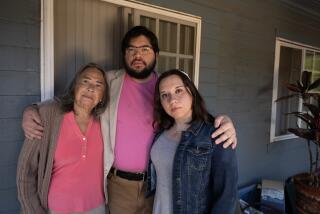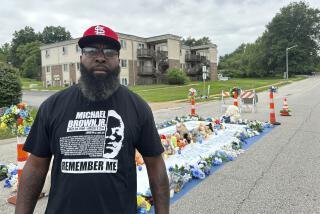Related story: ‘Two Fergusons’: Residents take a hard look at city’s racial divisions

Ferguson Mayor James Knowles talks about trying to help his community.
- Share via
Reporting from Ferguson, Mo. — When community leaders in this St. Louis suburb called a meeting last week to grapple with the aftermath of the Michael Brown police shooting, almost every face in the crowd of nearly 200 was white.
All but a handful of the city’s black residents, who make up two-thirds of the population, stayed away. Some were protesting near the scene of Brown’s shooting just three miles away. Others were worried they would be subject to scrutiny and criticism.
Still others had not heard about the meeting, which was advertised largely through word of mouth, via email and Facebook.
“They could have got the word out to me. If we communicate better, we can get more done,” said Sierra Smith, 27, a black resident of Canfield Green Apartments, where Brown was killed. Smith has become an activist since the shooting.
The racial divide that existed here before the 18-year-old’s death at the hands of a white police officer now looms large, frustrating many.
“Obviously, there are two Fergusons,” a middle-aged woman told the audience at Thursday’s meeting. “It’s going to be hard to bridge the gap.”
Only a few blocks from the protests on West Florissant Avenue sit the stately Victorian homes of the Old Ferguson East neighborhood, which is full of wide lawns shaded by towering hemlock, sycamore and elm trees. Many in those neighborhoods say they don’t recognize the city of turmoil and blame that has been depicted in national media over the last two weeks.
“It’s a horrible thing that happened, but what you’re seeing on TV is not happening where my home is,” said Chris Shanahan, 39, who came to the Thursday meeting to sell “I [Heart] Ferg” T-shirts.
“Our community has been shown to be a war zone. I’ve heard it referred to as ‘Fergistan,’” Shanahan said. “What’s happening is three to four miles from my home, where you wouldn’t know this was happening. People are out walking with their dogs day and night, still.”
Since the shooting, Ferguson boosterism has abounded. Volunteers have sold about 1,500 of the Ferguson T-shirts, stickers and koozies and distributed nearly 6,000 lawn signs. At the community meeting, they distributed a list of Ferguson highlights, including the farmers market, Citizens Police Academy and a 17-year-old volunteer group called People Reaching Out for Unity and Diversity.
At the community meeting, some proposed beautifying the scene of the protests on West Florissant, or holding a parade. They plugged a new community center set to open this year.
Byron Conley, 51, one of the few black residents who attended, said he wanted to see more police outreach in his neighborhood, which is mostly black.
“I want you to come to my barbecue!” he said of police.
A white woman in the crowd called out, “They do come to our block parties!”
Lew Keathley, 52, insisted Ferguson police were active in the community, volunteering in schools and leading a Boy Scout troop.
“That should be recognized,” he said.
Linda Lipka, 50, a business owner wearing a “Ferguson Proud” T-shirt, tried to bridge the gap in understanding.
The day before, she had attended a forum about the shooting joined at the last minute by U.S. Atty. Gen. Eric H. Holder Jr.
She tried to convey how black residents there had described Ferguson.
“They feel oppressed, hurt, uninformed and not included,” she said.
Residents in the 400-unit Canfield Green Apartments were coping with rampant crime before Brown’s death, unaware the city has a neighborhood watch program advertised in predominantly white neighborhoods just a few streets away, Lipka said.
“They’re feeling so angry because, honestly, if I call in my neighborhood, [the police] come,” Lipka said, “We have to be humble.”
She said black residents didn’t feel represented — only one of the half-dozen City Council members is black — and proposed creating a ward to diversify the council.
A man in the audience shook his head.
“Sir,” Lipka said, shaking her head right back at him, “if they don’t feel it, they don’t feel it.”
Many at Thursday’s meeting were graduates of McCluer High School, which has become dramatically more diverse since 1970, when the city was 99% white.
Kyle McLafferty, a 2006 graduate who is white, said the audience did not reflect the relatively integrated nature of his high school class.
“This is McCluer class of —” he hesitated, leaving them with an uncomfortable pause. Some shouted out their class years: 1952, 1957, 1960. (Missouri schools started desegregating in 1954.)
McLafferty proposed providing black students with police academy scholarships and incentives to stay at the department.
“We have to find a way to desegregate ourselves,” he said.
There are still racially segregated neighborhoods here. But the divide is also a matter of perception. The median home price here is $70,000. Tract homes and modest split-level ranches abound. There are 10 homeowners associations, many of them diverse, such as Forrestwood and Jeske Park.
The historic downtown business district of red brick storefronts known as Citywalk includes a slew of successful black-owned businesses such as BKM Fitness Boot Camp, Exotic Trenz beauty salon and Drake’s Place grill, where Holder stopped Wednesday. The crowds at Cork Wine Bar and Corner Coffee House are racially mixed at times, though mostly white.
Shanahan, who lives in an integrated subdivision, said he was frustrated to see Ferguson “dragged through the mud.” Friends phoned from as far away as Colorado and California, concerned about his safety. When he invited relatives from St. Louis to attend last week’s farmers market, only one cousin showed up with his children.
Shanahan has no complaints about local police, but he’s trying to understand why others do.
“I have an expectation that people are all treated the same. Maybe that’s part of white privilege,” he said, adding that the shooting “can’t be forgotten or overlooked, but we have to move past it.”
Former Ferguson Mayor Brian Fletcher, who served the city for 28 years, escaping poverty to reside in Old Ferguson East, closed Thursday’s meeting by urging the crowd to come together.
“Wouldn’t it be nice if the legacy of Michael Brown is not his death, but how we overcame the tragedy and we’re now stronger than ever?” said Fletcher, 54. “That’s up to us.”
For more news, follow @mollyhf on Twitter.
More to Read
Sign up for Essential California
The most important California stories and recommendations in your inbox every morning.
You may occasionally receive promotional content from the Los Angeles Times.











